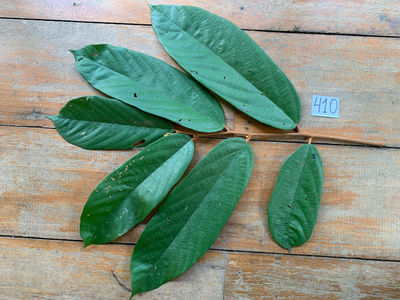top of page

IYARINA
Napo-Pastaza, Ecuador
CENTER FOR LEARNING ALLIANCE: Fundación Cotococha | Andes and Amazon Field School | Shayarina Amazonian Resilience
Theobroma subincanum
Family:
Malvaceae
Kichwa:
Kushillu kambi
Cofan:
Shan'cco Coquio'cho
Talking about Kushillu kambi
Eulodia Dagua - A wild cacao tree kills a man,
First he went [fishing] with his wife. As he fished with his wife they caught a lot of fish with barbasco. So he says “Now you go on ahead to clean the fish. So his wife starts going home to clean the fish. And he says, “I’ll go along [slowly] looking for game.” And so he circled around like that looking for game. So as he planned he was going along and killed a peccary, and then he killed a piping guan. After killing them, he looked up and saw that this tree was bearing a whole lot of wild cacao fruit (Theobroma subicanum). So, since it was loaded with fruit, he thought he would climb up and eat a few. He laid down the peccary like this and the guan like that, climbed up and started picking and pealing a lot fruit. And while he was harvesting, they say the [tree] spirit came, threw him down and killed him. Because he was killed, he didn’t show up, and didn’t show up, and when he didn’t arrive home they say [his wife wondered], “Why doesn’t he come? He was going to come quickly.” Then in the late afternoon she went [out there]. And when she went to look they say [she found] her husband lying there already killed. Long, long dead. He was lying there with the game [he had killed]. Her husband was [lying there] dead too. So then when she saw this, they say his wife hurried back to tell people about the kambi tree. So the people went to retrieve the corpse. They say that this kambi tree spirit killed this man like this. He killed him because he was protecting his fruit. They say he was killed for taking the fruit. That’s what they used to say... Swanson: He was killed because...? Yes, they say it killed that man because it didn’t want to share its kambi fruit. That why our elders say you should be wary you eating this when the tree is heavily loaded with fruit”. Now they say that you should eat and harvest quickly and then go [get out of there]. “That’s how that kambi tree kills,” they used to say
Swanson: [Is there any kind of polite asking that you can do so that the kambi tree spirit doesn’t kill you? ] (paraphrased)
You say to him, “I am eating your kambi fruit. I am just eating a little, I am not eating a lot ,” they say you when you eat his kambi fruit. That is how one should eat it. In that case he would not have done him harm. But he was killed because he wanted to harvest all of it.
Swanson: [Now can you show us how one should ask?] (paraphrased).
He should have said, [caressing the tree] “I am not taking a lot of your fruit. I only want to take a little. One should climb up after asking “[Please] don’t do anything to me. And as you speak you should caress the tree like this, caressing it like this as you talk. That is how you should talk when you eat [this fruit]” my grandfather used to tell us.
Kichwa Text
Ñaupa punda warmindi rishka payga. Warmindi rikga, mashti pescadogunata ambisha ashkata apishka. Chi kunan kanga ñaupa Frisha chunchulluri niswhkai. Chi, chasna nikpiga Warmia ña chuzhilingawa wasi aungak rishka. Payga “ñuka kasna riu aichata rikusha,” nishka. Kasna muyumun ña sacha aichata rikusha. Chi chasna nisha rikga shu lumukuchita wanchishka, chmanda shu karundzita wanchishka. Wanchisha shamukpiga awama rikukpi kay muyuga mana kaylla aparishka ashka puka kambi. Chi ashka aparishka akpiga sikasha mikushalla nishka payga. Lumu cuchita kasnama, karundzita kasnma churashaga chiga pay away sikasha ashkata apish llushkara chi muyuta. Chi pallashkaigashi supay shamushashi ichachisha wanchishkara paytaga. Wanchikpiga mana rikurishka, mana rikurishka, wasimaga mana paktashkaga, imawashi mana shamun? Wayrashina shamun mara. Ña chishi indí rikungak rishka. Rikunga rikpiga, ña unay wañuchishkashi siriushkara kariga. Unay, unay, wañushka. Aichagunandi chima siriushka ara, karis wañushka. Chiga chita rikuk warmiga vultarik runagunata rimakshi kay kambimanda, runagunataga, wañushkata apachik ara. Chiga kay kambi supayshi chasna wanchira chi runata. Pay mitsasha wanchishka, kambi muyuta mitsashashi wanchira. Chasna nisha kwintak anun.
A ao chi kambi muyuta mitsashashi wanchira chi runata. Chi raygu kaytaga manzhasha upina an ashka aparishkata an nisha ñukanchi rukugunaga. Kunaga wayrashina upisha, pallasha, rina nisha. Chasna chi kambiga wanchik ak an nik an.
Chiga, payga “ñukaga kamba kambitami upiuni. Ansallatami upiuni. Mana ashkata upiunichu nishashi upinawas paywa kambitaga. Chasna rimasha upina ak ashka. Chiga payta mana dañota rashkaga. Payga win payllapanga nishami wanchik ak ashka
Payga nina ashkai “Mana yapata kamba muyuta apaunichu. Ñukaga ansawallata apauni nisha. Ama imawatas rawaunguichu nisha sikana ak ashkai. Chasna rimasha ruyata chasna llangasha, chasna llangasha rimasha. Chasna nisha upina nisha ñuka apayayara tukuywa aranchi. ñukanchita rimak chasna nisha.
Eulodia Dagua - Wild Cacao Tree Kills a Greedy Man
Pukukpi upina muyuman kay puka kambiak ruya chi sachaybi ashka apariwn kayta machin mikurianun kay muyuta pakisha pay ilata shina,pakisha machin mikuman.
Chi chasna sachaybi kayta antiguo rukugunas payna puringawas rishas raykay shamukshas kuchushawas mikuksha kay kambie muyuga
Chiga payna wasimaga ña saksalla mikusha pakta ajakshka chi kayga mashti chasnaybi shuk runaga pay anvingawa yakuta riushka karuta.
Chi chasnaybi yakuta anvisha chi nishka rikusha kaytaga ryusha ñuka warmirayku apasha risha kay kambita sikasha pallasha apasha risha.

Ceramic representation of a “cambiaj muyu” Theobroma subicanum fruit by Estela Dagua.

bottom of page






